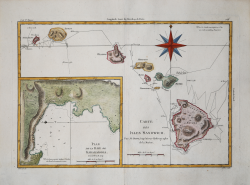




| Reference: | S36115 |
| Author | Rigobert BONNE |
| Year: | 1787 |
| Zone: | Hawaii |
| Printed: | Paris |
| Measures: | 364 x 250 mm |



| Reference: | S36115 |
| Author | Rigobert BONNE |
| Year: | 1787 |
| Zone: | Hawaii |
| Printed: | Paris |
| Measures: | 364 x 250 mm |
Striking full color example of Cook's first map of Hawaii, showing Cook's tracks through the Islands, including dates, topographical features of the islands and a large insert of Karakakooa Bay.
Cook left Hawaii in 1779, after coasting most of the major islands and having done a remarkably accurate job of mapping the islands for a first visit. The great debate regarding this map is whether the work was done by Henry Roberts or William Bligh of Mutiny on the Bounty Fame. While the text of the Official Account of Cook's Third Voyage credits Henry Roberts as the surveyor and maker of the charts, the British Hydrographical Office copy of the Official Account includes a manuscript annotation in Henry Bligh's own hand, wherein Bligh claims to have been the maker of this map and to have constructed the maps of Hawaii.
The present example appeared in Bonne's Atlas Supplement, published in Paris in 1787, which includes many of the maps derived from Cook's three voyages in Volume II.
Rigobert Bonne (1727-1795) was one of the most important cartographers of the late 18th century. In 1773 he succeeded Jacques Bellin as Royal Cartographer to France in the office of the Hydrographer at the Depôt de la Marine. Working in his official capacity Bonne compiled some of the most detailed and accurate maps of the period. Bonne's work represents an important step in the evolution of the cartographic ideology away from the decorative work of the 17th and early 18th century towards a more detail oriented and practical aesthetic. With regard to the rendering of terrain Bonne maps bear many stylistic similarities to those of his predecessor, Bellin. However, Bonne maps generally abandon such common 18th century decorative features such as hand coloring, elaborate decorative cartouches, and compass roses. While mostly focusing on coastal regions, the work of Bonne is highly regarded for its detail, historical importance, and overall aesthetic appeal.
The Atlas Encyclopédique, that Bonne completed with the help of Nicholas Desmarest, constitutes his most famous work.
Copperplate with fine later hand colour, very good condition.
Rigobert BONNE (1727 - 1795 ca.)
|
Rigobert Bonne was born in 1727 in Raucourt, in the Lorraine region of northeastern France. He was not only a cartographer but also a hydrographer who produced both land and nautical maps; he spent much of his career working in the French Hydrographic Office or Dépôt des cartes et plans de la Marine. As Royal Hydrographer, Bonne's main interest was the production of nautical maps, but he also gave to print a considerable number of other works, including maps by other cartographers who were his collaborators. He first came to prominence producing a series of plates for the Atlas Moderne ou Collection De Cartes Sur toutes les parties du Globe Terrestre par Plusieurs Auteurs, edited by Giovanni Antonio Rizzi Zannoni and first published in Paris by Jean Lattré in 1762, and subsequently reprinted-with the addition of numerous plates by other cartographers-until the end of the century. But he is probably best known for later publications, including the Atlas Encyclopedique-in collaboration with Nicholas Desmarest (1725-1805)-as well as for the maps he made for Guillaume Raynal's Atlas de Toutes Les Parties Connues du Globe Terrestre (1780). His maps were often commissioned more for educational and informational purposes than for practical use. In 1773, Bonne's talent was rewarded with the title of "Hydrographe du Roy," succeeding Jacques-Nicolas Bellin. From him took its name the pseudoconic projection, adopted, among other things, for the general map of France.
|
Rigobert BONNE (1727 - 1795 ca.)
|
Rigobert Bonne was born in 1727 in Raucourt, in the Lorraine region of northeastern France. He was not only a cartographer but also a hydrographer who produced both land and nautical maps; he spent much of his career working in the French Hydrographic Office or Dépôt des cartes et plans de la Marine. As Royal Hydrographer, Bonne's main interest was the production of nautical maps, but he also gave to print a considerable number of other works, including maps by other cartographers who were his collaborators. He first came to prominence producing a series of plates for the Atlas Moderne ou Collection De Cartes Sur toutes les parties du Globe Terrestre par Plusieurs Auteurs, edited by Giovanni Antonio Rizzi Zannoni and first published in Paris by Jean Lattré in 1762, and subsequently reprinted-with the addition of numerous plates by other cartographers-until the end of the century. But he is probably best known for later publications, including the Atlas Encyclopedique-in collaboration with Nicholas Desmarest (1725-1805)-as well as for the maps he made for Guillaume Raynal's Atlas de Toutes Les Parties Connues du Globe Terrestre (1780). His maps were often commissioned more for educational and informational purposes than for practical use. In 1773, Bonne's talent was rewarded with the title of "Hydrographe du Roy," succeeding Jacques-Nicolas Bellin. From him took its name the pseudoconic projection, adopted, among other things, for the general map of France.
|